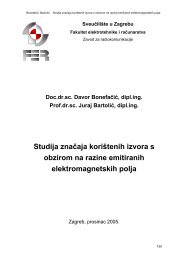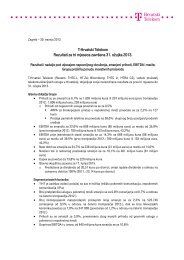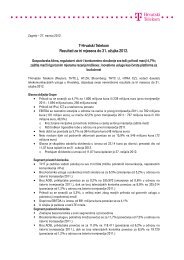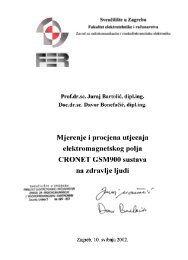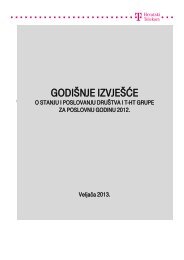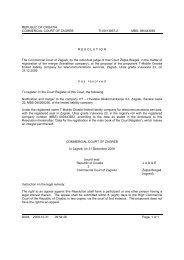Annual Report 2011 - T-Hrvatski Telekom
Annual Report 2011 - T-Hrvatski Telekom
Annual Report 2011 - T-Hrvatski Telekom
Create successful ePaper yourself
Turn your PDF publications into a flip-book with our unique Google optimized e-Paper software.
83<br />
substance of the tax), the Group presented the tax<br />
net of revenue (similar to a sales tax) rather than as an<br />
operating expense. Due to the significant magnitude<br />
of this tax, a change in the Group’s assumptions<br />
could have a material impact on total revenues, but<br />
would not have an impact on results of operations.<br />
2.4 Summary of accounting policies<br />
a) Operating profit<br />
Operating profit is defined as the result before<br />
income taxes and finance items. Finance items<br />
comprise interest revenue on cash balances in<br />
the bank, deposits, treasury bills, interest bearing<br />
available for sale financial assets, dividend income<br />
from associate and joint venture, interest expense on<br />
borrowings, gains and losses on the sale of available<br />
for sale financial assets and foreign exchange gains<br />
and losses on all monetary assets and liabilities<br />
denominated in foreign currency.<br />
2) Business Combinations and Goodwill<br />
Subsidiaries are all entities over which the Group has<br />
the power to govern the financial and operating policies<br />
generally accompanying a shareholding of more than<br />
one half of the voting rights. The existence and effect<br />
of potential voting rights are currently exercisable or<br />
convertible are considered when assessing whether the<br />
Group controls another entity.<br />
The Group applies the acquisition method to account for<br />
business combinations. The consideration transferred<br />
for the acquisition of a subsidiary is the fair values of the<br />
assets transferred, the liabilities incurred to the former<br />
owners of the acquiree and the equity interests issued<br />
by the Group. The consideration transferred includes<br />
the fair value of any asset or liability resulting from a<br />
contingent consideration arrangement. Identifiable<br />
assets acquired and liabilities and contingent liabilities<br />
assumed in a business combination are measured<br />
initially at their fair values at the acquisition date. The<br />
Group recognizes any non-controlling interest in the<br />
acquiree on an acquisition-by-acquisition basis, either at<br />
fair value or at the non-controlling interest’s proportionate<br />
share of the recognized amounts of acquiree’s<br />
identifiable net assets. Acquisition-related costs are<br />
expensed as incurred.<br />
If the business combination is achieved in stages, the<br />
acquisition date fair value of the acquirer’s previously<br />
held equity interest in the acquiree is remeasured<br />
to fair value as at the acquisition date through the<br />
statement of comprehensive income.<br />
Any contingent consideration to be transferred by the<br />
Group is recognized at fair value at the acquisition<br />
date. Subsequent changes to the fair value of the<br />
contingent consideration that is deemed to be an<br />
asset or liability is recognized in accordance with<br />
IAS 39 either in statement of comprehensive income<br />
or as a change to other comprehensive income.<br />
Contingent consideration that is classified as equity<br />
is not remeasured, and its subsequent settlement is<br />
accounted for within equity.<br />
Goodwill is initially measured as the excess of the<br />
aggregate of the consideration transferred and the<br />
fair value of non-controlling interest over the net<br />
identifiable assets acquired and liabilities assumed.<br />
If this consideration is lower than the fair value of the<br />
net assets of the subsidiary acquired, the difference is<br />
recognized in the statement of comprehensive income.<br />
Following initial recognition, goodwill is measured at<br />
cost less any accumulated impairment losses.<br />
Inter-company transactions, balances, income and<br />
expenses on transactions between group companies<br />
are eliminated. Profits and losses resulting from intercompany<br />
transactions that are recognized in assets<br />
are also eliminated. Accounting policies of subsidiaries<br />
have been changed where necessary to ensure<br />
consistency with the policies adopted by the Group.<br />
c) Investment in associate<br />
In the Group’s financial statements, investment in<br />
associated company (generally a shareholding of<br />
between 20% and 50% of voting rights) where<br />
significant influence is exercised by the Group are<br />
accounted for using the equity method less any<br />
impairment in value. Under the equity method, the<br />
investment is initially recognized at cost, and the carrying<br />
amount is increased or decreased to recognize the<br />
investor’s share of the profit or loss of the investee after<br />
the date of acquisition. An assessment of investment<br />
in associate is performed when there is an indication<br />
that the asset has been impaired or that the impairment<br />
losses recognized in previous years no longer exist.<br />
Consolidated financial statements



